第一讲 机器人导论
- 格式:ppt
- 大小:2.85 MB
- 文档页数:33
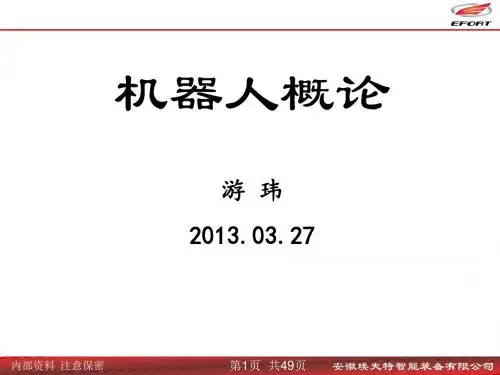
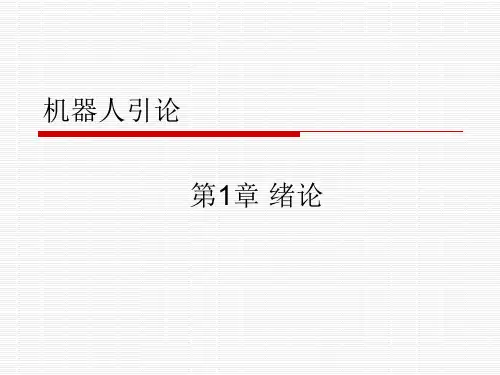

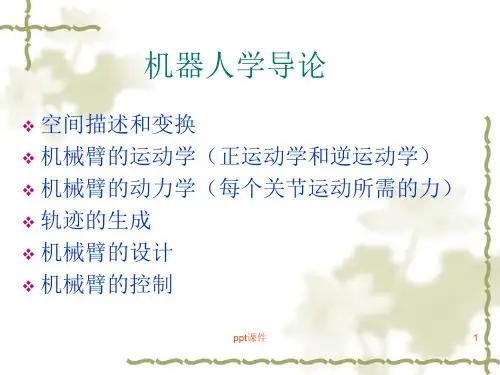
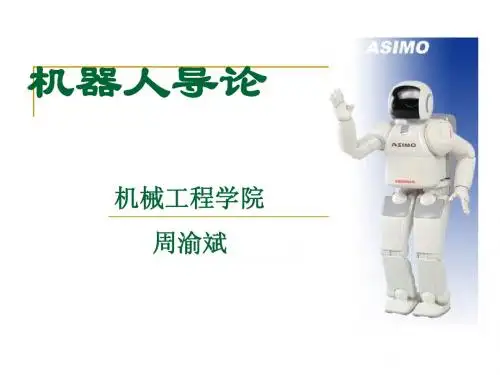
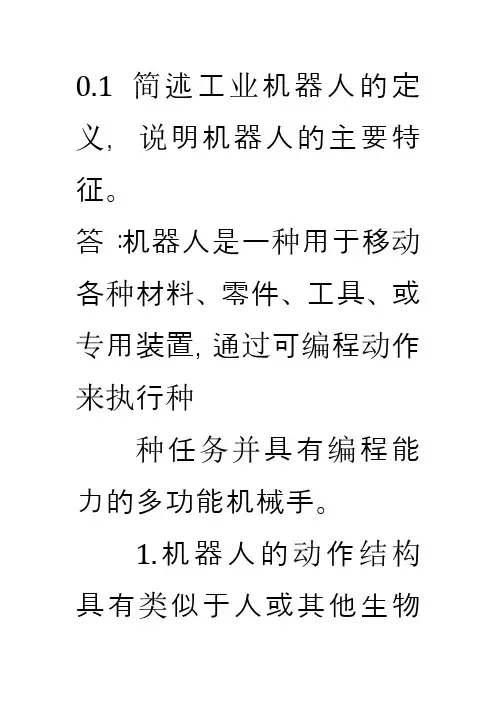
0.1 简述工业机器人的定义,说明机器人的主要特征。
答:机器人是一种用于移动各种材料、零件、工具、或专用装置,通过可编程动作来执行种种任务并具有编程能力的多功能机械手。
1.机器人的动作结构具有类似于人或其他生物体某些器官(肢体、感官等)的功能。
2.机器人具有通用性,工作种类多样,动作程序灵活易变。
3.机器人具有不同程度的智能性,如记忆、感知、推理、决策、学习等。
4.机器人具有独立性,完整的机器人系统在工作中可以不依赖于人的干预。
0.2工业机器人与数控机床有什么区别?答:1.机器人的运动为开式运动链而数控机床为闭式运动链;2.工业机器人一般具有多关节,数控机床一般无关节且均为直角坐标系统;3.工业机器人是用于工业中各种作业的自动化机器而数控机床应用于冷加工。
4.机器人灵活性好,数控机床灵活性差。
0.5简述下面几个术语的含义:自有度、重复定位精度、工作范围、工作速度、承载能力。
答:自由度是机器人所具有的独立坐标运动的数目,不包括手爪(末端执行器)的开合自由度。
重复定位精度是关于精度的统计数据,指机器人重复到达某一确定位置准确的概率,是重复同一位置的范围,可以用各次不同位置平均值的偏差来表示。
工作范围是指机器人手臂末端或手腕中心所能到达的所有点的集合,也叫工作区域。
工作速度一般指最大工作速度,可以是指自由度上最大的稳定速度,也可以定义为手臂末端最大的合成速度(通常在技术参数中加以说明)。
承载能力是指机器人在工作范围内的任何位姿上所能承受的最大质量。
0.6什么叫冗余自由度机器人?答:从运动学的观点看,完成某一特定作业时具有多余自由度的机器人称为冗余自由度机器人。
0.7题0.7图所示为二自由度平面关节型机器人机械手,图中L1=2L2,关节的转角范围是0゜≤θ1≤180゜,-90゜≤θ2≤180゜,画出该机械手的工作范围(画图时可以设L2=3cm )。
1.1 点矢量v 为]00.3000.2000.10[T,相对参考系作如下齐次坐标变换:A=⎥⎥⎥⎥⎦⎤⎢⎢⎢⎢⎣⎡--100.9000.1000.0000.00.3000.0866.0500.00.11000.0500.0866.0写出变换后点矢量v 的表达式,并说明是什么性质的变换,写出旋转算子Rot 及平移算子Trans 。

机器人技术导论课后习题1、智能机器人的含义是什么?因为这样,我们才说这种机器人才是真正的机器人,尽管它们的外表可能有所不同。
2、直流电机的额定值有哪些?答:型号、额定功率、额定电压、额定电流、额定转速、励磁方式、励磁电压、励磁电流、定额、绝缘等级、额定温升。
3、机器人视觉的硬件系统由哪些部分组成?答:光源:用于表现特征光源控制器:用于给光源供电镜头:用于成像延长管:用于改变像距相机:用于物理图像到电子信号的转换采集卡:用于将相机中的电子信号传输到计算机中计算机、嵌入式系统、智能相机等:用于分析图像机器视觉软件:用于处理图像,得到所以需要数据结果运动控制:用于控制气缸、机械手、马达等运动,以完成机器的功能传感器:位置传感器、存在传感器、安全传感器,用于判断产品有没有、到位否之类4、简述模糊控制器的组成及各组成部分的用途。
答:模糊逻辑控制器由4个基本部分组成,即模糊化、知识库、推理算法和逆模糊化。
(1) 模糊化:将检测输入变量值变换成相应的论域,将输入数据转换成合适的语言值。
(2) 知识库:包含应用领域的知识和控制目标,它由数据和模糊语言控制规则组成。
(3) 推理算法:从一些模糊前提条件推导出某一结论,这种结论可能存在模糊和确定两种情况。
(4) 逆模糊化:将推理所得到的模糊值转换为明确的控制讯号,作为系统的输入值。
5、试述机器人滑模变结构控制的基本原理。
答:滑模变结构控制是变结构控制系统的一种控制策略。
这种控制策略与常规控制的根本区别在于控制的不连续性,即一种使系统“结构”随时间变化的开关特性。
该控制特性可以迫使系统在一定特性下沿规定的状态轨迹作小幅度、高频率的上下运动,即所谓的“滑动模态”或“滑模”运动。
这种滑动模态是可以设计的,且与系统的参数及扰动无关。
这样,处于滑模运动的系统就具有很好的鲁棒性。
6、机器人轨迹控制过程如图所示。
试列出各步的主要内容。
答:1)通过示教过程得到机器人轨迹上特征点的位姿。

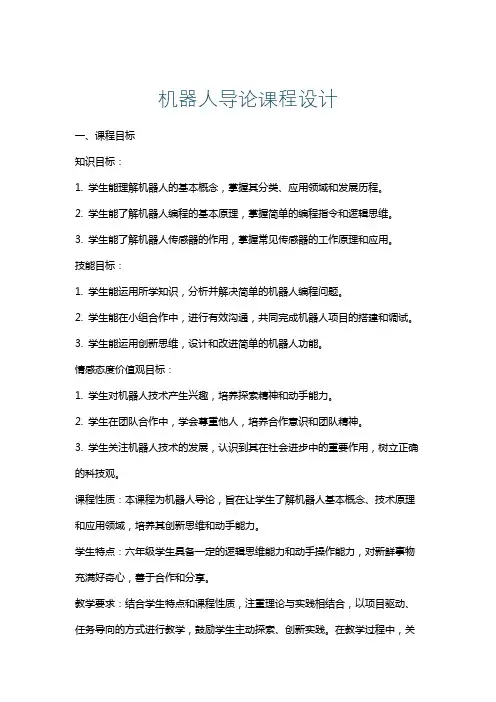
机器人导论课程设计一、课程目标知识目标:1. 学生能理解机器人的基本概念,掌握其分类、应用领域和发展历程。
2. 学生能了解机器人编程的基本原理,掌握简单的编程指令和逻辑思维。
3. 学生能了解机器人传感器的作用,掌握常见传感器的工作原理和应用。
技能目标:1. 学生能运用所学知识,分析并解决简单的机器人编程问题。
2. 学生能在小组合作中,进行有效沟通,共同完成机器人项目的搭建和调试。
3. 学生能运用创新思维,设计和改进简单的机器人功能。
情感态度价值观目标:1. 学生对机器人技术产生兴趣,培养探索精神和动手能力。
2. 学生在团队合作中,学会尊重他人,培养合作意识和团队精神。
3. 学生关注机器人技术的发展,认识到其在社会进步中的重要作用,树立正确的科技观。
课程性质:本课程为机器人导论,旨在让学生了解机器人基本概念、技术原理和应用领域,培养其创新思维和动手能力。
学生特点:六年级学生具备一定的逻辑思维能力和动手操作能力,对新鲜事物充满好奇心,善于合作和分享。
教学要求:结合学生特点和课程性质,注重理论与实践相结合,以项目驱动、任务导向的方式进行教学,鼓励学生主动探索、创新实践。
在教学过程中,关注学生的学习成果,及时进行评估和反馈,以提高教学效果。
二、教学内容本课程教学内容分为以下几个部分:1. 机器人基本概念:介绍机器人的定义、分类、应用领域和发展历程,对应教材第一章。
2. 机器人编程原理:讲解机器人编程的基本概念、编程语言和编程逻辑,对应教材第二章。
3. 机器人传感器:介绍传感器的作用、类型和工作原理,以及常见传感器的应用,对应教材第三章。
4. 机器人项目实践:结合所学知识,进行机器人编程、搭建和调试的实践活动,对应教材第四章。
具体教学安排如下:第一周:机器人基本概念(第一章)第二周:机器人编程原理(第二章)第三周:机器人传感器(第三章)第四周:机器人项目实践(第四章)教学内容注重科学性和系统性,以教材为基础,结合实际案例,使学生能够逐步掌握机器人相关知识和技能。
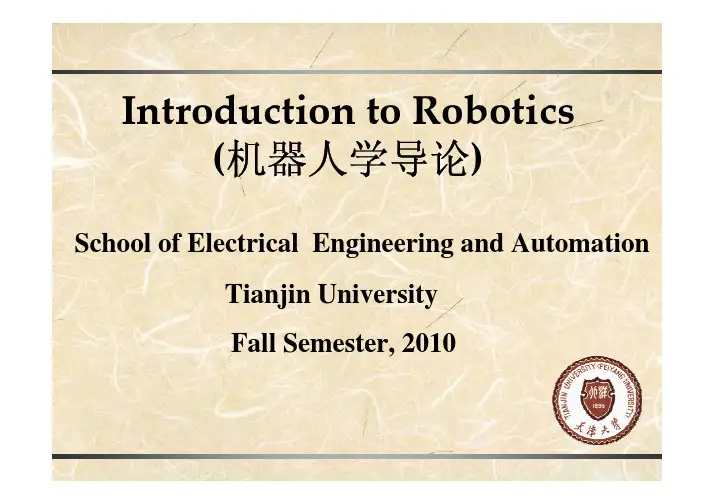
Introduction to Robotics(机器人学导论)School of Electrical Engineering and AutomationTianjin UniversityFall Semester, 2010•Time: Monday Night(Room 115, Section A,Building No. 26)Week 1st to Week 8th•Instructor: Dr. Xian, Bin (鲜斌)•Office: Room 525, Section E, Building No.26•Office Hours: 3:00 pm to 5:00 pm, Wednesday •E-mail : xbin@•Text Book and Reference Books1.John J. Craig, Introduction to Robotics: Mechanics AndControl, Third Edition, Pearson Education, 2005.约翰J. 克拉格,机器人学导论,机械工业出版社,2006.¥49$732.Saeed B. Niku, 机器人学导论-分析、系统及应用,孙富春等翻译,电子工业出版社,2004.3. Mark W. Spong, M. Vidyasagar, Robotics and Control, John Wiley& Sons, 2004.•Grading: Homework 20%Final exam 80%•Course Outline1.Background and Introduction2.Rigid Motion and Homogeneous Transformation3.Forward Manipulator Kinematics4.Inverse Manipulator Kinematics5.Velocity Kinematics6.Manipulator Dynamics7. Control of ManipulatorsChapter 1 IntroductionHollywood’s RobotsR2-D2T800Ch1.1Background1. What is a robot?By general agreement, a robot is:A programmable machine that imitates the actions orappearance of an intelligent creature–usually a human.A robot (industrial robot) is a reprogrammable,multifunctional manipulator designed to move materials, parts, tools, or specialized devices, through variable programmedmotions for the performance of a variety of tasks.(definition from Robotics Institute of American)¾ A Robot is controlled by a computer or similar device.¾ A Robot can be easily re-programmed.2.JIRA Standards for Robot¾Human-Controlled System¾Fixed Sequence Robot¾Alterable Sequence Robot¾Playback RobotRIA ¾Numerical Controlled Robot¾Intelligent Robot•Type of robots¾Robot Manipulator¾Ground Mobile Robot¾Under Water Robot¾Humanoid Robot3.What is Robotics?¾Robotics is the technology and knowledge that are used for design and application of robots.4.Robotics is a interdisciplinary research area:¾Mechanical Engineering: methodologies for the study of machine in static and dynamic situation …¾Electrical Engineering: design of sensor, actuator, interface, control algorithms, ….¾Computer Sciences: software, vision, intelligence….¾Mathematics¾BiologyCh1.2History of Robotics1.1922, Karel Capkef’s novel “Rossum’s Universal Robots”,--Rabota2.1952, First Numerical Control Machine Tool by MIT3.1954, First Re-programmable Robot by George Devol4.1955, Homogeneous Transformation by Denavit &Hartenberg5.1962, First Industry Robot by Unimation6.1968, First Intelligent Robot (Shakey)by SRI7.1972, Cartesian Space Robot by IBM (to IBM7565 Robot)8.1973, T3 Robot by Cincinnati Mialcron9.1978, PUMA Robot by Unimation10.1983, Robotics course were provided in many universitiesStanford Research Institute ---ShakeyUnimation-Puma RobotCh1.3Components of Robot •What a robot will contain?1.Manipulator or Mobile Vehicle2.End-effector3.Actuator: Servo Motor, Stepper Motor, HydraulicCylinder…4.Sensor: Resolvers/Potentiometers, Tachometer, StrainGauge, Encoder…5.Controller6.Processor7.Software: OS, Robot Software, Application Routines …Ch1.4Architecture of RobotEnvironmental sensors Motionplanner ControllerMechanicalStructureConfigurationsensorProcessorPower Supply CommunicationUser InterfaceCh1.5DOF of Robot•The Number of degree of freedom: the number of independent position variables that would have to bespecified in order to locate all the parts of the mechanism.•How to determine the location of a point in three dimension space?•How to determine the location of a rigid objective in three dimension space?Both position and orientation of the objective are needed!•For the robot with DOF greater than 6, there is no identical solution for the system.•What is the number of DOF for human’s arm?•Due to the structure of actuator, there is limited DOF, i.e,0.5 DOF.A B•Number of DOF for robot is determined by its application,i.e, robot for PCB assembly often has 3.5 DOFCh1.5Robot Joints•Main types: Rotary Joint, Prismatic Joint, and Ball Joint•It is customary to classify robots of kinematically simple class according to the design of their joints(the positioningstructure).•P: Prismatic JointR: Rotary JointS: Ball Jointi.e, 3P3R, 2RSCartesian (3P)Cylindrical (R2P)Spherical(2RP)Articulated (3R)SCARA: Selectively Compliant Assembly Robot ArmAdept Cobra s350 (2RP)Ch1.7Performance of Robot •Load Capacity: depends upon the size of its structural members, power-transmission systems and actuator. Example: Adept S1700 6 Axis Robot, Wight 280kg, payload 10kg(rate)/20kg(maximum)•Workspace: The maximum distance that the robot can reached within its working area.•Speed: be determined by robot’s application.•Accuracy: how accurately a robot can reach its destination, some industry robots can meet 0.001 inch ( or 0.0254mm) or higher accuracy.•Repeatability: the accuracy for a robot to reach the same destination for given times, most industry robots can reach0.001 inch or higher level.Ch1.8Application of Robot •Installed Industry Robots•Industry¾Welding¾Painting¾Assembly¾Pick and Place¾Diagnosis•Biotechnology¾Micro/Nano Manipulation¾Sample Handling¾Automated Analysis•MedicalSurgery, Rehabilitation ….•Military Application ¾Reconnaissance¾Battle field fighting¾Search¾Rescue•Space ExplorationMars Exploration Rovers: twin robot geologist, landed on Mars on Jan 3and 4, 2004Chinese Lunar Rovers: test inthe desert•EntertainmentSony QrioSony I-sobot RobotHonda ASIMOSony Qrio ---Fan DanceCh1.9Robot Coordinate System •Global Reference Coordinate System (frame)XY Z•Joint Reference Coordinate System (frame)XYZ(base)1θ2θ3θ•Tool Reference Coordinate System (frame)XYZ(base)X1Y1Z1Ch1.10Forward Kinematics •Kinematics: the science of motion that treats motion without regard to the forces which cause it.•Within the sciences of kinematics, we study position, velocity, acceleration and all higher derivative of theposition variables.•Kinematics refers to all the geometrical and time-based properties of the motion.•Forward kinematics: static geometrical problem of computing the position and orientation of the end-effector of the manipulator.•Given a set of joint angles, how to compute the position an orientation of the tool frame relative to the base frame.XYZ(base)X1Y1Z11θ2θ3θ•Inverse Kinematics: given the position and orientation of the end-effector, calculate all possible set of joint angles that could be used to attain this specified position and orientation.XYZ(base)X1Y1Z11θ2θ3θCh1.11Inverse Kinematics•This problem can be considered as a mapping of locations in external 3-D Cartesian space to locations in the robot’sinternal joint space.•The inverse kinematics problem is more complicate than the forward kinematics¾The kinematic equations are nonlinear, the solutionprocedure is not always easy.¾Existence of the solution? and multiple solution?Ch1.12Velocity Kinematics •Velocity Kinematics: derive the velocity relationship, relating the linear and angular velocities of the end-effector (or any other point on the robot) to the joint velocitiesXYZ(base)vw3θ2θ1θ•Jacobian Matrix: specifies a mapping from velocities in the joint space to velocities in the Cartesian space.•The nature of this mapping changes as the configuration of the robot varies.•Singularities: at certain points, the mapping is not invertible.Ch1.13Robot Dynamics •Dynamics: study devoted to study the force required to cause motion.XYZ(base)AV 1τ2τ3τ•The exact form of the required actuator torquedepends on mass properties of the robotlink/payload, the attributes of the path taken by the end-effector.•Robot dynamic mode can be utilized in¾calculating the desired actuator torque functionto drive the robot to follow desired trajectory¾simulationCh1.14Robot Control•Why need to consider robot control problem?¾The vast majority of manipulator are driven byactuators that supply a force or a torque to cause themotion of robot.¾An algorithm is needed to compute torque/force thatwill caused the desire motion.•Linear position control: control algorithm design based on linear approximations to the dynamics of a robot.•Nonlinear position control: control algorithm design based on the nonlinear dynamics of a robot.Ch1.15Summary •Definition and classification of robot •History of robot•Structure of robot•Application of robot•Basic concepts of robotics•Research on open problem¾Manipulation, Locomotion¾Navigation, Control¾Learning an Adaptation (AI)¾Human-Robot Interaction¾Biologically inspired robotThank You!。
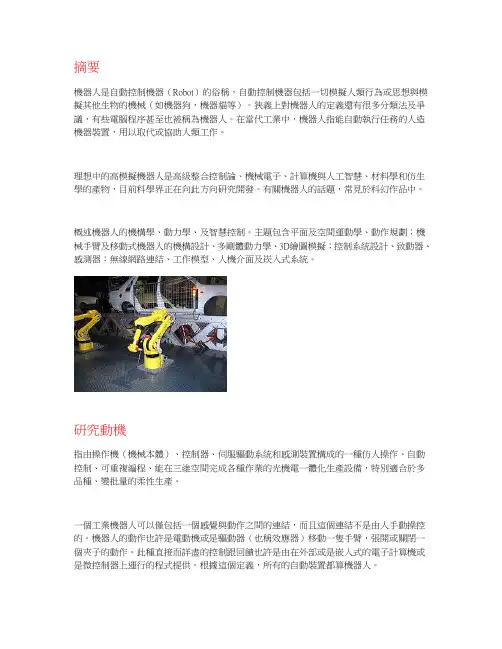
摘要機器人是自動控制機器(Robot)的俗稱,自動控制機器包括一切模擬人類行為或思想與模擬其他生物的機械(如機器狗,機器貓等)。
狹義上對機器人的定義還有很多分類法及爭議,有些電腦程序甚至也被稱為機器人。
在當代工業中,機器人指能自動執行任務的人造機器裝置,用以取代或協助人類工作。
理想中的高模擬機器人是高級整合控制論、機械電子、計算機與人工智慧、材料學和仿生學的產物,目前科學界正在向此方向研究開發。
有關機器人的話題,常見於科幻作品中。
概述機器人的機構學、動力學、及智慧控制。
主題包含平面及空間運動學、動作規劃;機械手臂及移動式機器人的機構設計、多剛體動力學、3D繪圖模擬;控制系統設計、致動器、感測器:無線網路連結、工作模型、人機介面及崁入式系統。
研究動機指由操作機(機械本體)、控制器、伺服驅動系統和感測裝置構成的一種仿人操作、自動控制、可重複編程、能在三維空間完成各種作業的光機電一體化生產設備,特別適合於多品種、變批量的柔性生產。
一個工業機器人可以僅包括一個感覺與動作之間的連結,而且這個連結不是由人手動操控的。
機器人的動作也許是電動機或是驅動器(也稱效應器)移動一隻手臂,張開或關閉一個夾子的動作。
此種直接而詳盡的控制跟回饋也許是由在外部或是嵌入式的電子計算機或是微控制器上運行的程式提供。
根據這個定義,所有的自動裝置都算機器人。
工業機器人可直接接受人類指令,也可以執行預先編排的程序,也可以根據以人工智慧技術制定的原則綱領行動。
工業機器人現狀2007 年全球共新安裝工業機器人114,365 台,較2006 年新安裝的111,052 台,上升了3%。
截至2007 年底,全球工業機器人保有量已達到了995,000 台。
2007 年,亞洲及美洲工業機器人的裝配量明顯上升,汽車工業以及電子電器行業的發展是上述地區工業機器人裝配量強勁增長的主要因素。
此外,化工領域用工業機器人的需求量也迅速上升。
研究目地目的是成為教育和研究領域的領導者。
机器人导论课后学习13301084-钟奎(1)ARM的发展简史ARM最早于1990年由Acorn改组而来,之前Acorn时期开发出自己第一代32位、6MHz、3.0μm处理器,即ARM1,并用它做出一台 RISC指令集的计算机,也就是说当时还是在沿袭传统的方式,自己设计芯片出售芯片,早期使用Acorn 芯片产品的包括苹果的Newton pad等。
RISC 即精简指令集计算机,起初为达到降低售价把面积设计的小,功耗低是顺带的优势,而价格低廉功耗少天然适合移动设备,1990年11月,从苹果获得150万英镑投资,从VLSI获25万英镑投资,Acorn则是12个工程师和作价150万英镑的IP,外加一个办公的谷仓,重组后的Acorn开启世界标准之旅。
初创时期的ARM没有商业经验没有管理经验,当然也没有世界标准这种愿景,运营资金紧张,工程师人心惶惶,最后ARM决定自己不生产芯片,转而以授权的方式将芯片设计方案转让给其他公司,即“Partnership”开放模式,公司在1993年实现盈利,1998年纳斯达克和伦敦证券交易所两地上市,同年基于ARM 架构芯片出货达5000万片。
进入2000年,开始受益于手机以及其他电子产品的迅速普及,ARM系列芯片呈爆炸性增长,2001年11月出货量累积突破十亿片,2011年基于ARM系列芯片单年出货79亿片,年营收4.92亿英镑(合7.85亿美元),净利润1.13亿英镑。
ARM 的发展代表了半导体行业某种趋势,即从完全的垂直整合到深度的专业化分工,70年代半导体行业普遍采用上中下游的垂直整合封闭式生产体系,80年代开始半导体行业开始分化,出现垂直整合和分工化的系统制造、定制集成等两个体系,台积电的晶圆代工模式进一步推动了专业分工的发展,半导体行业分工进一步细化,形成IP、设计、晶圆、封装价上下游体系,ARM处于价值链顶端。
(2)STM32系列微控制器的特点STM32系列给MCU用户带来了前所未有的自由空间,提供了全新的32位产品选项,结合了高性能、实时、低功耗、低电压等特性,同时保持了高集成度和易于开发的优势。